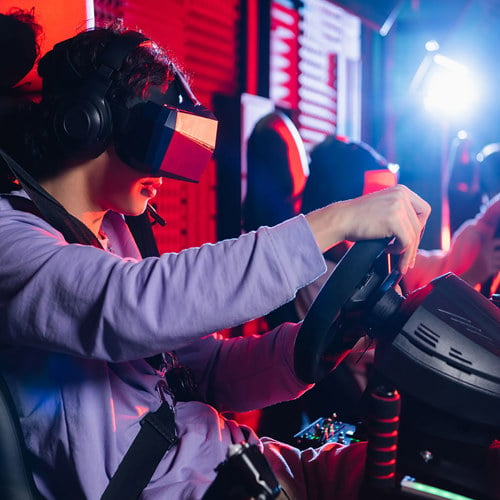Gaming technology is key to cost effective virtual reality simulations that are helping improve our transport systems, writes Ian Cornwell of Mott MacDonald.
Engineers working on improving transport systems are finding many uses for virtual reality (VR) simulations. Some use cases are entirely new, but the idea of using realistic driving simulations to investigate road user behaviour goes back at least as far as the 1970s. Sophisticated driving simulator facilities have been developed over decades, but when it came to recent research into road user behaviour around stopped vehicles on live lanes of highways, the decision was taken to base the VR simulations on mainstream gaming technology instead — and that proved its value, especially during COVID-19 restrictions!
Stopped vehicles on live highways have had a lot of publicity in the UK, and are a potential safety hazard for all highways across Europe. Road authorities felt uninformed about how road users respond to stopped vehicle incidents; whether they know how to safely navigate the hazards, whether they should make a report, differences in behaviour in different lighting and weather conditions and how they respond to various kinds of driver information. By understanding behaviour, the road authorities can optimise their incident response actions and even road user education.
Investigating road behaviour
European roads authorities wanted an international study, looking at behaviour in multiple countries. Although realism was important, it was more important to reach a wide sample of people in different places. So rather than making people travel to rare and elite facilities, a solution was developed to run anywhere.
To get realistic traffic patterns, the developers use a ‘microsimulation’ traffic model of the type used by professional transport modellers to investigate the performance of road schemes. The microsimulation model defines the world that we want to explore and interact with, then a mainstream VR engine from the computer gaming world presents this as virtual reality.
We use the Unreal Engine, with Blueprints as a visual scripting language, and C++ where needed for special elements (yes, we’re still occasionally writing C++ in the 2020s!); another common approach is to use Unity with C# for controlling interaction and customisation. Visual scripting approaches like Blueprints are popular especially with engineers who are not full-time professional programmers. Skills readily available in the IT and engineering industries can then be used to develop the VR. Developers easily customise the simulations to produce both drive-on-right and drive-on-left versions, day and night versions, and portray different numbers of lanes, amounts of traffic, and weather conditions. Different kinds of driver information are injected: no information, on-road warnings, roadside sign settings, traffic radio and modern in-vehicle alert information.
Simulation trial results
A standalone executable is produced so that the VR experience can be run on any suitable computer equipped with a commercial VR gaming headset. This setup can be easily replicated at any location. When driver behavioural trials were due in the recent European research, COVID-19 was still a prominent threat to varying degrees in each country. Lockdown was over, but people were avoiding travel. A gaming based VR solution then proved its worth — rather than having members of the public coming to a dedicated physical facility for driving simulation, the solution could be taken to any convenient location, even the homes of the participants. The trials were completed with the target number of participants in all countries.
For you
Be part of something bigger, join BCS, The Chartered Institute for IT.
Not everyone finds themselves equally comfortable with VR: ‘virtual reality sickness’ is a documented effect with symptoms similar to motion sickness. In the traffic simulations, all participants were briefed on the possible adverse effects, but none were experienced. That could be due to each simulation only lasting 5 minutes, and each participant doing several simulation runs with breaks in between.
The trials exposed a wide variety of driver behaviour that could be analysed further by behavioural and traffic specialists who were able to consider steps to reduce risks on the road. Perhaps not surprisingly, the availability of driver information had a positive effect on safety, and the reactions of the participants indicated what information is most useful and when. Road authorities are considering how to use the findings to improve their operational processes for managing incidents and informing and educating drivers.
Engaging thinking about transport system change
It has become common to use VR to allow stakeholders to visualise possible designs of the built environment, including working transport infrastructure, before it is agreed and built. Visualisation removes the technical barrier for the public to understand the proposed scheme. In more recent developments, traffic and pedestrian activities are simulated accurately by the integration of transport modelling software. Members of the public can even experience travel on their own future routes in virtual reality. Stakeholders in construction use VR to understand what they are going to build. Again the VR experiences are developed using the same mainstream gaming technology that proves cost-effective and sustainable in IT skills. The feedback that is generated is used to improve infrastructure designs to avoid usability issues that can be missed when using older design visualisation methods.
VR is even introducing new people to the topic. As part of promoting our profession in society, we take a transport VR experience into schools. Students are shown a generic street layout and then asked to make suggestions of how to improve walking and cycling. The effect can be realised in seconds in the software, and the students can experience their suggestions in virtual reality.
A next step for this kind of simulation capability is to integrate live measurements from the real world into the simulation environment in real time — perhaps then starting to earn the much used term ‘digital twin’.
VR is just one aspect of the growing disciplines of digital design and construction, where automation, parametric design and even generative AI design are changing the way that engineers work.
About the author
Ian Cornwell leads Mott MacDonald’s software engineering community, represents UK in European standardisation for traffic data, and led the driver research funded by national road authorities of Austria, Belgium (Wallonia), Finland, Germany, Hungary, Ireland, the Netherlands, Sweden, and UK, collaborating via CEDR (Conference of European Directors of Roads). Ian is grateful to Cedric Kwok, Mott MacDonald’s Gamification & Visualisation lead.

















